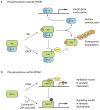The SUMO pathway: emerging mechanisms that shape specificity, conjugation and recognition
- PMID: 21102611
- PMCID: PMC3079294
- DOI: 10.1038/nrm3011
The SUMO pathway: emerging mechanisms that shape specificity, conjugation and recognition
Abstract
Proteins of the small ubiquitin-related modifier (SUMO) family are conjugated to proteins to regulate such cellular processes as nuclear transport, transcription, chromosome segregation and DNA repair. Recently, numerous insights into regulatory mechanisms of the SUMO modification pathway have emerged. Although SUMO-conjugating enzymes can discriminate between SUMO targets, many substrates possess characteristics that facilitate their modification. Other post-translational modifications also regulate SUMO conjugation, suggesting that SUMO signalling is integrated with other signal transduction pathways. A better understanding of SUMO regulatory mechanisms will lead to improved approaches for analysing the function of SUMO and substrate conjugation in distinct cellular pathways.
Figures





References
-
- Johnson ES. Protein modification by SUMO. Annu Rev Biochem. 2004;73:355–382. - PubMed
-
- Geiss-Friedlander R, Melchior F. Concepts in sumoylation: a decade on. Nature Rev Mol Cell Biol. 2007;8:947–956. - PubMed
-
- Kerscher O, Felberbaum R, Hochstrasser M. Modification of proteins by ubiquitin and ubiquitin-like proteins. Annu Rev Cell Dev Biol. 2006;22:159–180. - PubMed
-
- Guo D, et al. A functional variant of SUMO4, a new I kappa B alpha modifier, is associated with type 1 diabetes. Nat Genet. 2004;36:837–841. - PubMed
Publication types
MeSH terms
Substances
Grants and funding
LinkOut - more resources
Full Text Sources
Other Literature Sources

